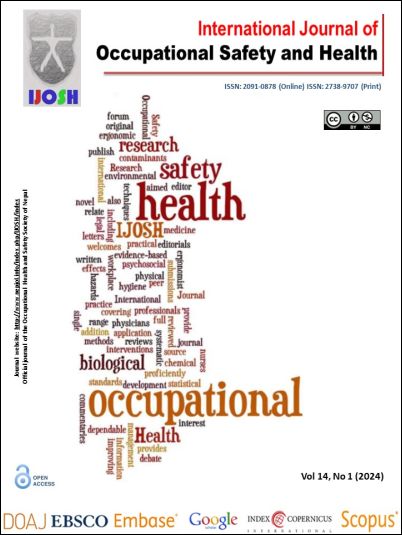Statistical Data Analysis in Emergency Management Elements of Indian State of Tamil Nadu Manufacturing Industries Utilising LPG
DOI:
https://doi.org/10.3126/ijosh.v14i1.48606Keywords:
Communication System adopted in plant, Fire Protection, Emergency Health Services, Emergency Management Elements, SafetyAbstract
Introduction: Process safety is becoming more difficult as requirements increase. When balancing quality, volume, and safety on a budget, major accidents are unavoidable. The inability of organizations to absorb unwelcome and unanticipated disruptions is a major contributor to complacency and a decline in safety attitudes. The inability of industries to interpret standards impedes self-regulation.
Methods: A total of 50 emergency management element questionnaires were developed to evaluate the state of an industry. These questionnaires were categorized as first aid, personal protective equipment (PPE), communication systems used in plants, safety education and training, occupational hygiene and health, management systems on accident reporting, safety and health, analysis and investigation, and procedures and protocols. From 32 LPG industries in Tamil Nadu districts, information for all 50 questions was gathered and the statistical tool "Analysis ToolPak" in Excel 2010 was used to analyze the data.
Results: This study conducted a comprehensive statistical analysis of various aspects of industrial on-site emergency planning. The questionnaire's reliability was determined using Cronbach's alpha test. Utilizing descriptive statistics, t-tests for means, one-way ANOVA, and histograms, statistical evaluation was conducted. Encouragingly, all the results were favorable, providing compelling evidence that the LPG-utilizing industries in various regions of Tamil Nadu, India, are exceeding safety requirements.
Conclusion: In conclusion, the findings suggest that improved legal frameworks, laws, and implementation of EME in communication systems can greatly enhance the development of safety in plants, fire protection, and emergency health services. These measures can significantly reduce the occurrence of accidents and improve the response time to emergencies, ultimately saving lives and reducing property damage.
Downloads
Downloads
Published
How to Cite
Issue
Section
License
Copyright (c) 2023 Gnanasekara Baburao, A. Anitha , Srinivas T, R.K. Elangovan, Govindarajan R

This work is licensed under a Creative Commons Attribution-NonCommercial 4.0 International License.
This license enables reusers to distribute, remix, adapt, and build upon the material in any medium or format for noncommercial purposes only, and only so long as attribution is given to the creator.





